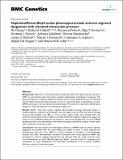| dc.contributor.author | Chang, Bo | |
| dc.contributor.author | Peters, Maureen | |
| dc.contributor.author | Zabaleta, Adriana | |
| dc.contributor.author | Nusinowitz, Steven | |
| dc.contributor.author | Smith, Richard S. | |
| dc.contributor.author | Savinova, Olga V. | |
| dc.contributor.author | Hawes, Norman L. | |
| dc.contributor.author | Martin, Janice E. | |
| dc.contributor.author | Davisson, Muriel L. | |
| dc.contributor.author | Cepko, Connie | |
| dc.contributor.author | Hogan, Brigid L. M. | |
| dc.contributor.author | John, Simon W. M. | |
| dc.date.accessioned | 2013-01-04T21:40:25Z | |
| dc.date.issued | 2001 | |
| dc.identifier.citation | Chang, Bo, Richard S. Smith, Maureen Peters, Olga V. Savinova, Norman L. Hawes, Adriana Zabaleta, Steven Nusinowitz, et al. 2001. Haploinsufficient Bmp4 ocular phenotypes include anterior segment dysgenesis with elevated intraocular pressure. BMC Genetics 2:18. | en_US |
| dc.identifier.issn | 1471-2156 | en_US |
| dc.identifier.uri | http://nrs.harvard.edu/urn-3:HUL.InstRepos:10139277 | |
| dc.description.abstract | Background: Glaucoma is a blinding disease usually associated with high intraocular pressure (IOP). In some families, abnormal anterior segment development contributes to glaucoma. The genes causing anterior segment dysgenesis and glaucoma in most of these families are not identified and the affected developmental processes are poorly understood. Bone morphogenetic proteins (BMPs) participate in various developmental processes. We tested the importance of Bmp4 gene dosage for ocular development and developmental glaucoma. Results: \(Bmp4^{+/-}\) mice have anterior segment abnormalities including malformed, absent or blocked trabecular meshwork and Schlemm's canal drainage structures. Mice with severe drainage structure abnormalities, over 80% or more of their angle's extent, have elevated IOP. The penetrance and severity of abnormalities is strongly influenced by genetic background, being most severe on the C57BL/6J background and absent on some other backgrounds. On the C57BL/6J background there is also persistence of the hyaloid vasculature, diminished numbers of inner retinal cells, and absence of the optic nerve. Conclusions: We demonstrate that heterozygous deficiency of BMP4 results in anterior segment dysgenesis and elevated IOP. The abnormalities are similar to those in human patients with developmental glaucoma. Thus, BMP4 is a strong candidate to contribute to Axenfeld-Rieger anomaly and other developmental conditions associated with human glaucoma. BMP4 also participates in posterior segment development and wild-type levels are usually critical for optic nerve development on the C57BL/6J background. \(Bmp4^{+/-}\) mice are useful for studying various components of ocular development, and may allow identification of strain specific modifiers affecting a variety of ocular phenotypes. | en_US |
| dc.language.iso | en_US | en_US |
| dc.publisher | BioMed Central | en_US |
| dc.relation.isversionof | doi://10.1186/1471-2156-2-18 | en_US |
| dc.relation.hasversion | http://www.ncbi.nlm.nih.gov/pmc/articles/PMC59999/pdf/ | en_US |
| dc.relation.hasversion | http://www.biomedcentral.com/1471-2156/2/18 | en_US |
| dash.license | LAA | |
| dc.title | Haploinsufficient Bmp4 Ocular Phenotypes Include Anterior Segment Dysgenesis with Elevated Intraocular Pressure | en_US |
| dc.type | Journal Article | en_US |
| dc.description.version | Version of Record | en_US |
| dc.relation.journal | BMC Genetics | en_US |
| dash.depositing.author | Cepko, Connie | |
| dc.date.available | 2013-01-04T21:40:25Z | |
| dash.affiliation.other | HMS^Ophthalmology | en_US |
| dash.affiliation.other | HMS^Genetics | en_US |
| dc.identifier.doi | 10.1186/1471-2156-2-18 | * |
| dash.authorsordered | false | |
| dash.contributor.affiliated | Cepko, Constance | |


